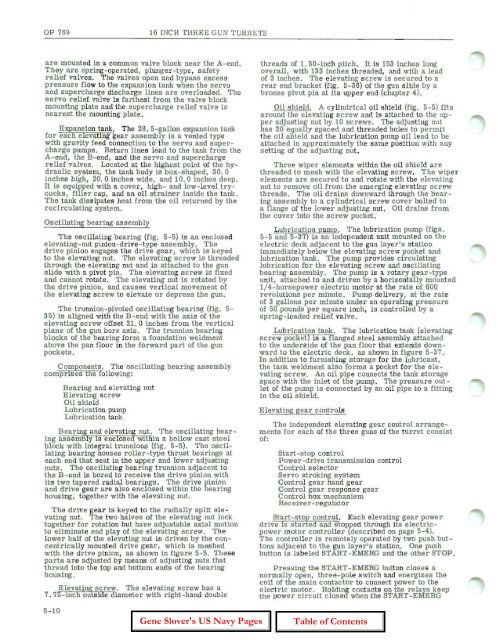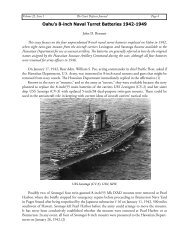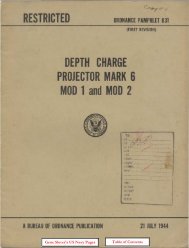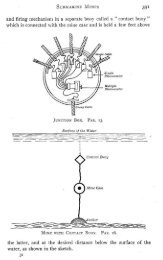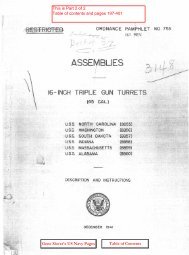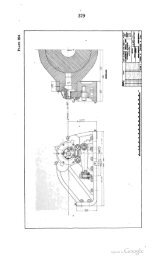OP-769 16" Three Gun Turrets Part 2 - Personal Page of GENE ...
OP-769 16" Three Gun Turrets Part 2 - Personal Page of GENE ...
OP-769 16" Three Gun Turrets Part 2 - Personal Page of GENE ...
Create successful ePaper yourself
Turn your PDF publications into a flip-book with our unique Google optimized e-Paper software.
<strong>OP</strong> <strong>769</strong> 16 INCH THREE GUN TURRETS<br />
are mounte d in a common valve block near the A-end.<br />
They are spring-operated, plunger-type, s aIety<br />
relief valves. The valves open and bypass excess<br />
pressu.re flow to the expansion tank when the servo<br />
and s upercharge discharge lines are overloaded. The<br />
servo r elief valve is farthes t from the valve block<br />
mounting plate and the supercharge relief valve is<br />
nearest the mounting plate.<br />
Expansion tank. The 28 . 5-gallon expansion tank<br />
for each e levahng gea r asse mbly is a vent ed type<br />
with gravity feed connection t o t he servo and supercharge<br />
pumps . Retur n lines lead t o the tank from the<br />
A-end, the B-end, and the s e rvo and supercharge<br />
r elief valves. Located at the highest point <strong>of</strong> the hy <br />
draulic system, t he tank body is box-shaped, 30.0<br />
inches high, 20. 0 inches wide, and 10.0 inches deep.<br />
It is equipped with a cover , high- and low-level trycocks,<br />
fille r cap, and an oil strainer inside the tank.<br />
The tank dissipates heat from the oil returned by the<br />
reCirculating s ystem.<br />
Oscillating bearing as sembly<br />
The oscillating bearing (fig. 5- 5) is an enclosed<br />
elevating-nut pinion-drive -type assembly. The<br />
drive pinion engages the drive gear , which is keyed<br />
to the elevating nut . The e levating screw is t hreaded<br />
through the elevat ing nut and is attached to the gun<br />
slide with a pivot pin. The elevating screw is fixed<br />
a nd cannot rotat e . The elevat ing nut is rotate d by<br />
the drive pinion, and causes vertical movement <strong>of</strong><br />
the elevating s crew to elevate or depress the gun.<br />
The trunnion-pivoted oscillating bearing (fig. 5-<br />
35) is aligned with the B-end with the axis <strong>of</strong> the<br />
e levating screw <strong>of</strong>fset 21. 0 inches from the vertical<br />
plane <strong>of</strong> the gun bore axis . The trunnion bearing<br />
blocks <strong>of</strong> the bearing form a foundation weldment<br />
above the pan floor in the forward part <strong>of</strong> the gun<br />
pOckets.<br />
Components. The oscillating bearing assembly<br />
compnses the following:<br />
Bear ing and elevating nut<br />
Elevating s crew<br />
Oil s hield<br />
LubricatIon pump<br />
Lubrication tank<br />
Bearuw and elevating nut. T he oscillating bearing<br />
assem 1y is enclosed WIthin a hollow cast steel<br />
b lock with integral trunnions (fig. 5- 5). The oscillating<br />
bear ing houses rOller-type thrust bearings at<br />
each end that s eat in the upper and lower adjus ting<br />
nuts. The oscillating bearing t runnion adjacent t o<br />
the B-end is bored t o r eceive t he drive pinion with<br />
its two taper ed radial bear ings. The drive pinion<br />
and drive gear a r e also enclos ed within the bearing<br />
hous ing, together with the elevating nut.<br />
The drive gear is keyed to the radially split ele <br />
vating nut. The two halves <strong>of</strong> the elevating nut lock<br />
togethe r for rotation but have adjustable axial motion<br />
to eliminate end play <strong>of</strong> the elevating screw. The<br />
lowe r half <strong>of</strong> the elevat ing nut is driven by the concentrically<br />
m ounted drive gear , which is meshed<br />
with the drive pinion, as s hown in figure 5-5. These<br />
parts are adjusted by means <strong>of</strong> adjust ing nuts that<br />
thread into the top and bottom ends <strong>of</strong> the bearing<br />
hOUSing.<br />
Elevating screw. The e levating screw has a<br />
7. 75-inch outside diameter with right-hand double<br />
5-10<br />
threads <strong>of</strong> 1. 50-inch pitch. It is 153 inches long<br />
overall, with 133 inches thr eaded, and with a lead<br />
<strong>of</strong> 3 inches . The e levating s crew is secured to a<br />
rear end bracket (fig. 5-36) <strong>of</strong> the gun s lide by a<br />
bronze pivot pin at its upper end (chapter 4).<br />
Oil s hield. A cylindrical oil shield (fig. 5-5) fits<br />
around the e levating s crew and is attached to the upper<br />
adjusting nut by 10 screws. The adjusting nut<br />
has 20 equally spaced and threaded holes t o permit<br />
the oil shield and the lubr ication pump oil lead to be<br />
attached in appr Oximately the s ame position with a ny<br />
s etting <strong>of</strong> the adjusting nut.<br />
<strong>Three</strong> wiper elements within the oil shield a r e<br />
threaded t o mesh with the elevating s crew. The wiper<br />
elements are secured t o and r otate with the e levating<br />
nut to r emove oil from the emerging elevating screw<br />
threads. The oil drains downward through the bearing<br />
assembly to a cylindrical s crew cover bolted to<br />
a flange <strong>of</strong> the lowe r adjusting nut. Oil drains from<br />
the cover into the screw pocket .<br />
Lubrication pump. The lubrication pump (figs.<br />
5-5 and 5-37) is an independent unit mounted on the<br />
e lectric deck adjacent t o the gun layer's st ation<br />
immediate ly below the el evating screw pocket and<br />
lubrication tank. The pump pr ovides circulating<br />
lubrication for the elevating sc rew and oscillating<br />
bearing assembly. The pump is a r otary gear-type<br />
unit, attached t o and driven by a horizontally mounted<br />
1/ 4- horsepower electric motor at the rate <strong>of</strong> 600<br />
revolutions per minute. Pump de liVery, at the rate<br />
<strong>of</strong> 3 gallons per minute unde r an operating pressure<br />
<strong>of</strong> 50 pounds pe r square inch, Is controlled by a<br />
spring-loaded relief valve.<br />
Lubrication tank. The lubrication tank (elevating<br />
s crew pocket) is a flanged steel assembly attached<br />
to the underSide <strong>of</strong> the pan floor that extends downward<br />
to the elect ric deck, as shown in figure 5-37.<br />
In addition to furnishing storage fo r the lubricant,<br />
the tank weldment also forms a pocket for the elevating<br />
screw. An oil pipe connects the tank s torage<br />
space with the inlet <strong>of</strong> the pump . The pressure outlet<br />
<strong>of</strong> the pump is connected by an oil pipe t o a fitting<br />
in the oil shie ld.<br />
E levating gear controls<br />
The independent elevating gear control arrange <br />
ments for each <strong>of</strong> the three guns <strong>of</strong> the turret consist<br />
<strong>of</strong>:<br />
Start-stop control<br />
Power-drive transmiSSion control<br />
Control selector<br />
Ser vo stroking system<br />
Control gear hand gear<br />
Control gear response gear<br />
Cont r ol box mechanism<br />
Receiver-regulator<br />
Start-stop control. Each elevating gear power<br />
drive is started and stopped through its electricpower<br />
motor controlle r (described on page 5-4).<br />
The controller is remotely operated by two push buttons<br />
adjacent t o the gun laye r 's station. One push<br />
button is labeled START-EMERG and the othe r ST<strong>OP</strong>.<br />
Pressing the START-EMERG button closes a<br />
normally open, three-pole switch and energizes the<br />
coil <strong>of</strong> the main contactor to connect power to the<br />
electric motor. Holding cont acts on the relays keep<br />
the power Circuit closed when the START-EMERG


